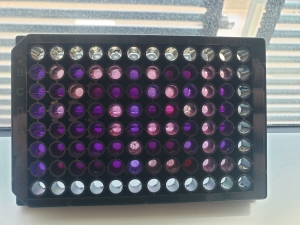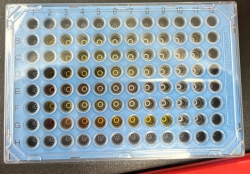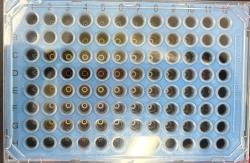Weeks like this are confusing. It felt like the busiest week of my life and the chillest at the same time. So much of what I was doing was wait wait wait then go at just the right minute. Working with cells and bacteria you have to pay attention to the timing of treatments and readings.
This week I built 3 new plates as well as read the one I built last week. Reading the plate meant that I was analyzing the amount of live bacteria left in the plate after we let it sit with the compounds. This first plate that I had was mixed with a live dead stain compound that showed either the bacteria being dead (blue) or very much alive (pink). From this stain we were able to determine the most effective compounds because they had the blue stain due to the fact that they killed the bacteria.
 Live dead dye on general botanical assay where the darker the color shows dead bacteria, indicating an effective compound.
Live dead dye on general botanical assay where the darker the color shows dead bacteria, indicating an effective compound. Effectiveness was determined by percent of living bacteria. Dr. Wlodarchak determined that anything that had a <20% living bacteria was effective and worth the further testing. Twelve compounds made this 20% or less list. One of the more surprising additions to this list is frankincense, a common fragrance, which had a 1% survival rate making it our most effective compound.
Now that we know what compounds were effective we are able to start testing at what concentrations they are effective at. The purpose of doing this is because the original concentrations that I tested were very high and most likely in a dosage would be toxic. To find the effective concentrations, the compounds are incrementally diluted into a serial dilution. These dilutions are going to be dyed for live dead next week. The best part of serial dilutions is seeing the beautiful color gradients created by the botanical solutions.


A beautiful color gradient of the 12 most effective compounds to determine the most effective concentration against bacteria.
The next new plate was a replica of the first one I had made. The first plate was the general screening of all of my botanical compounds against the Tuberculosis bacteria. Thanks to my new best friend The Robot, all I had to do was make up a new colony of bacteria, defrost my stock drug plate and let The Robot do all of the plating for me. After it was completed, a quick little label was made, and it went off into the incubator where it is going to sit for five days until I could stain it.
While it might seem like not much major "science-y" stuff happened this week, I got a clearer look at the day-to-day reality of working in a long-term research lab. At first glance, it can feel like there’s a lot of downtime while waiting for experiments to run, data to come in, or equipment to be ready.
But the truth is, those slower moments are valuable opportunities. They’re the perfect time to plan, prep, or analyze other aspects of your work. Using that time wisely can strengthen your research overall and keep your momentum going.
This mindset around time management translates easily back to school life. Instead of mindlessly scrolling through my phone during a random hour off, I could use that time to get a head start on laundry (and maybe avoid the Sunday night laundry that everyone seems to do). Even knocking out a bit of homework or doing some light cleaning can make a big difference. Small preparations and choices like these can go a long way in making life a little smoother overall.